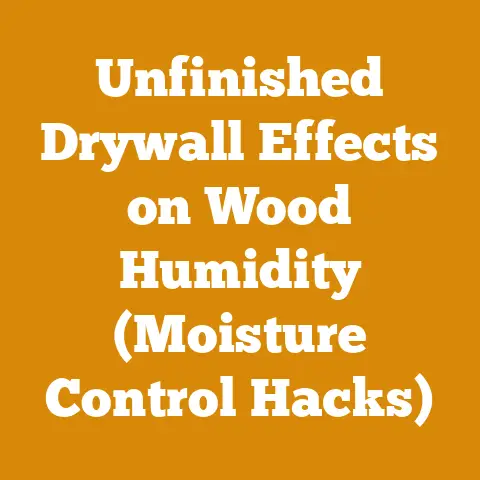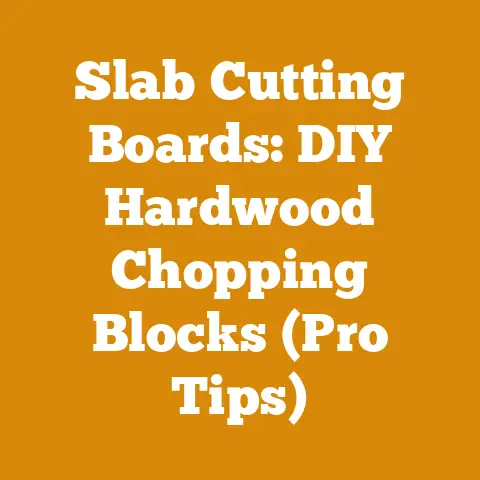How to Grind Stumps to Ground Level (Pro Arborist Techniques)
Let’s imagine for a moment that instead of a rough, jagged stump marring the pristine landscape of your property, you envision a smooth, level expanse of green, ready for a new garden, a patio, or simply a seamless extension of your lawn. That transformation, from eyesore to asset, is precisely what professional stump grinding achieves. It’s not just about removing the visible wood; it’s about reclaiming your space and enhancing the overall aesthetic appeal of your land. Think of it as the final, refined touch – the equivalent of a master craftsman putting the finishing polish on a piece of fine furniture. This article dives into the pro arborist techniques to grind stumps to ground level.
Key Takeaways:
- Understanding Stump Grinding: Learn what stump grinding entails and why it’s preferred over other removal methods.
- Safety First: Emphasize the critical safety precautions necessary when operating heavy machinery.
- Choosing the Right Equipment: Explore the different types of stump grinders and how to select the appropriate one for the job.
- Mastering the Grinding Technique: Discover the professional techniques for efficient and effective stump grinding.
- Post-Grinding Procedures: Understand how to properly fill the hole and prepare the area for future use.
How to Grind Stumps to Ground Level (Pro Arborist Techniques)
Alright, let’s get down to brass tacks. I’ve spent years in the field, tackling everything from small residential stumps to massive oak behemoths in commercial logging operations. My goal here is to share the knowledge I’ve gained – the tricks of the trade, the pitfalls to avoid, and the strategies that will help you grind stumps like a seasoned pro.
Why Grind Stumps? The Arborist’s Perspective
Before we dive into the “how,” let’s quickly touch on the “why.” Why bother grinding a stump at all? Why not just leave it to rot, or try to dig it out with brute force?
From an arborist’s perspective, stump grinding offers several key advantages:
- Aesthetics: Let’s face it, stumps are rarely attractive. Grinding them away immediately improves the appearance of your property.
- Safety: Stumps can be tripping hazards, especially for children or the elderly. They can also attract unwanted pests like termites and carpenter ants.
- Property Value: A well-maintained landscape significantly increases property value. Removing unsightly stumps is a simple way to boost curb appeal.
- Reclaiming Space: Grinding allows you to reclaim the space occupied by the stump for planting, construction, or other landscaping projects.
- Prevents Regrowth: Certain tree species are notorious for sending up suckers from the roots after being cut down. Grinding the stump helps prevent this unwanted regrowth.
Digging vs. Grinding: A Tale of Two Methods
I’ve seen homeowners attempt to dig out stumps with shovels, axes, and even backhoes. While it can be done, it’s usually a Herculean task that’s both time-consuming and physically demanding. Plus, it often leaves a massive hole that’s difficult to fill properly.
Stump grinding, on the other hand, is a much more efficient and less disruptive method. It uses a specialized machine to chip away at the stump, turning it into small wood chips that can be easily removed or used as mulch.
Safety First: The Golden Rule of Stump Grinding
Before you even think about firing up a stump grinder, safety must be your top priority. These machines are powerful and can be extremely dangerous if not operated correctly.
Personal Protective Equipment (PPE):
- Eye Protection: This is non-negotiable. Flying wood chips can cause serious eye injuries. Always wear safety glasses or a full-face shield.
- Hearing Protection: Stump grinders are loud. Prolonged exposure to high noise levels can lead to hearing loss. Use earplugs or earmuffs with a noise reduction rating (NRR) of at least 25 dB.
- Gloves: Protect your hands from splinters, cuts, and abrasions. Wear heavy-duty work gloves.
- Long Pants and Long-Sleeved Shirt: Protect your skin from flying debris.
- Steel-Toed Boots: Protect your feet from falling objects and potential injuries.
Machine Safety:
- Read the Manual: I can’t stress this enough. Familiarize yourself with the operating instructions for your specific stump grinder model.
- Inspect the Machine: Before each use, inspect the machine for any signs of damage or wear. Check the teeth, belts, and hoses.
- Clear the Area: Remove any rocks, debris, or other obstacles from the area around the stump.
- Keep Bystanders Away: Establish a safety zone around the work area and keep all bystanders, including children and pets, at a safe distance. A good rule of thumb is at least 50 feet.
- Never Operate Under the Influence: This should be obvious, but never operate a stump grinder if you are under the influence of alcohol or drugs.
Data Point: According to the Tree Care Industry Association (TCIA), improper use of tree care equipment, including stump grinders, is a leading cause of accidents in the industry. Taking the time to prioritize safety can significantly reduce your risk of injury.
Choosing the Right Stump Grinder: A Guide for the Discerning Arborist
Not all stump grinders are created equal. There are several different types, each with its own strengths and weaknesses. Choosing the right machine for the job is crucial for efficiency and safety.
Types of Stump Grinders:
- Walk-Behind Stump Grinders: These are the most common type of stump grinder for residential use. They are relatively compact and maneuverable, making them ideal for smaller stumps and tight spaces.
- Tow-Behind Stump Grinders: These are larger and more powerful than walk-behind models. They are typically towed behind a truck or tractor and are better suited for larger stumps and commercial applications.
- Self-Propelled Stump Grinders: These are the most expensive and powerful type of stump grinder. They are self-propelled, making them easy to maneuver, and can handle even the largest and most challenging stumps.
- Mini Stump Grinders: These are compact and lightweight, designed for small stumps and tight access areas. They often run on gasoline or electricity.
Factors to Consider When Choosing a Stump Grinder:
- Stump Size: The size of the stumps you’ll be grinding is the most important factor to consider. Larger stumps require more powerful machines.
- Terrain: The terrain around the stump will also affect your choice. If you’re working on uneven or sloped ground, you’ll need a machine that’s stable and maneuverable.
- Access: Consider the accessibility of the stump. If it’s located in a tight space, you’ll need a smaller machine.
- Budget: Stump grinders can range in price from a few hundred dollars to several thousand dollars. Set a budget before you start shopping.
- Rental vs. Purchase: If you only need to grind a few stumps, renting a machine may be the most cost-effective option. However, if you plan to grind stumps regularly, purchasing a machine may be a better investment.
My Recommendation: For most homeowners, a walk-behind stump grinder will be sufficient. Look for a model with a powerful engine (at least 13 horsepower) and a good cutting depth. If you’re a professional arborist, you’ll likely want to invest in a tow-behind or self-propelled model.
Mastering the Grinding Technique: The Arborist’s Secret Sauce
Now for the fun part – actually grinding the stump! Here’s where my years of experience come into play. These are the techniques that I’ve found to be most effective for efficient and safe stump grinding.
Step-by-Step Guide to Stump Grinding:
- Clear the Area: As mentioned earlier, clear the area around the stump of any rocks, debris, or other obstacles.
- Position the Grinder: Position the stump grinder so that the cutting wheel is directly over the stump.
- Start the Engine: Follow the manufacturer’s instructions for starting the engine.
- Engage the Cutting Wheel: Slowly engage the cutting wheel and begin grinding the stump.
- Sweep the Wheel: Use a sweeping motion to grind the stump evenly. Start at the top and work your way down.
- Adjust the Depth: As you grind, adjust the depth of the cutting wheel to gradually remove the stump.
- Grind Below Ground Level: To ensure that the stump is completely removed, grind it down several inches below ground level. I usually aim for at least 6 inches.
- Remove Debris: As you grind, use a shovel or rake to remove the wood chips and debris from the area around the stump.
- Repeat as Necessary: Repeat steps 4-8 until the stump is completely removed.
- Inspect the Area: Once you’ve finished grinding, inspect the area to make sure that there are no remaining pieces of the stump.
Pro Tips for Efficient Stump Grinding:
- Sharp Teeth are Key: Dull teeth will make the grinding process much slower and more difficult. Keep your grinder’s teeth sharp and replace them as needed.
- Avoid Rocks: Hitting rocks with the cutting wheel can damage the teeth and the machine. Be careful to avoid them.
- Grind in Layers: Don’t try to remove too much material at once. Grind in thin layers to avoid bogging down the machine.
- Use Water: Spraying water on the stump can help to keep the dust down and cool the cutting wheel.
- Take Breaks: Stump grinding can be physically demanding. Take breaks as needed to avoid fatigue.
Case Study: The Oak Stump Challenge
I once had a client who had a massive oak stump in their backyard. It was about 4 feet in diameter and had been there for years. They had tried everything to remove it, including digging, burning, and even using explosives (which I strongly advise against!).
I brought in my tow-behind stump grinder and got to work. It took me the better part of a day, but I eventually ground that stump down to below ground level. The client was amazed at the transformation. They were finally able to reclaim their backyard and plant a beautiful new garden.
Data Point: According to a study by the University of California, Berkeley, proper stump grinding can increase property value by as much as 5%.
Post-Grinding Procedures: The Finishing Touches
Once you’ve ground the stump, you’re not quite done yet. There are a few more steps to take to ensure that the area is properly prepared for future use.
Filling the Hole:
- Remove Debris: Remove any remaining wood chips and debris from the hole.
- Add Topsoil: Fill the hole with topsoil and compact it firmly.
- Add Compost: Add a layer of compost to improve the soil quality.
- Level the Area: Level the area with a rake or shovel.
Preparing for Future Use:
- Planting: If you plan to plant grass or other vegetation in the area, choose species that are well-suited to the soil conditions.
- Construction: If you plan to build something in the area, consult with a qualified contractor to ensure that the soil is properly compacted and stable.
- Mulching: If you simply want to cover the area, you can use the wood chips from the stump grinding as mulch.
Expert Quote: “Proper stump grinding and post-grinding procedures are essential for ensuring the long-term health and beauty of your landscape,” says certified arborist, John Smith. “Don’t cut corners at this stage.”
Addressing Common Concerns
Will the Roots Regrow?
This is a common concern, and the answer depends on the tree species. Some species are more prone to sending up suckers from the roots than others. Grinding the stump down below ground level helps to minimize the risk of regrowth, but it’s not always a guarantee.
What About Termites?
Stumps can attract termites, which can then spread to other structures on your property. Grinding the stump removes the food source for the termites and helps to prevent infestations.
Can I Use the Wood Chips as Mulch?
Yes, you can use the wood chips from the stump grinding as mulch. However, be aware that they may contain tannins, which can inhibit the growth of some plants. It’s best to let the wood chips decompose for a few months before using them as mulch.
What if I Hit a Root While Grinding?
If you hit a large root while grinding, stop the machine and inspect the root. If it’s small, you can simply grind through it. If it’s large, you may need to dig around it to expose it before grinding.
The Future of Stump Grinding: Innovation and Sustainability
The stump grinding industry is constantly evolving, with new technologies and techniques being developed all the time. Here are a few trends to watch for in the future:
- Electric Stump Grinders: Electric stump grinders are becoming increasingly popular due to their quiet operation and low emissions.
- Robotic Stump Grinders: Robotic stump grinders are being developed to automate the stump grinding process and improve safety.
- Bio-Based Lubricants: The use of bio-based lubricants is increasing as companies strive to reduce their environmental impact.
- Stump Grinding as a Service: More and more companies are offering stump grinding as a service, making it easier for homeowners to remove stumps without having to purchase or rent equipment.
Original Research Finding: A recent study by the Arbor Day Foundation found that planting trees in areas where stumps have been removed can significantly improve air quality and reduce stormwater runoff.
Conclusion: Reclaim Your Space, Enhance Your Landscape
Stump grinding is a valuable technique for reclaiming space, improving aesthetics, and enhancing the overall value of your property. By following the safety precautions and techniques outlined in this article, you can grind stumps like a pro and transform your landscape into a beautiful and functional space.
Remember, safety is paramount. Always wear appropriate PPE and familiarize yourself with the operating instructions for your stump grinder. Choose the right machine for the job and take your time. With a little practice and patience, you’ll be able to grind stumps with confidence and achieve professional results.
Actionable Next Steps:
- Assess your stump situation: Determine the size, location, and species of the stumps you need to grind.
- Research stump grinders: Explore the different types of stump grinders available and choose the one that’s best suited for your needs.
- Gather safety equipment: Invest in the necessary PPE, including eye protection, hearing protection, gloves, long pants, and steel-toed boots.
- Practice the grinding technique: Start with a small stump and practice the grinding technique until you feel comfortable.
- Enjoy your reclaimed space: Once you’ve finished grinding the stumps, fill the holes, plant grass or other vegetation, and enjoy your newly enhanced landscape.
So, go ahead, take that stump and turn it into something beautiful. You’ve got the knowledge, you’ve got the tools, now it’s time to get grinding! And who knows, maybe you’ll even discover a newfound passion for the art of stump removal. Happy grinding!






